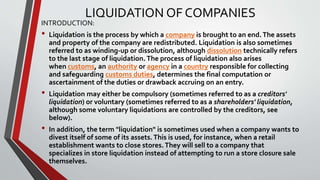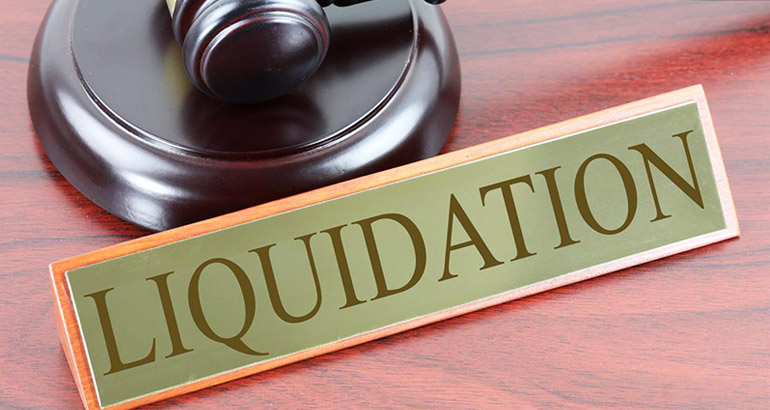Company Liquidation - Questions
Wiki Article
Company Liquidation - An Overview
Table of ContentsThe Buzz on Company LiquidationThe Best Guide To Company Liquidation10 Simple Techniques For Company LiquidationWhat Does Company Liquidation Do?Not known Details About Company Liquidation
An MVL is the easiest. Supervisors and investors involve an agreement, and the company is sold and liquidated. No court orders are included and revenues are separated in between investors as soon as any kind of last payments to creditors have been made. Lenders' voluntary liquidation (CVL) is a where the business directors know its insolvent position and come to an arrangement with financial institutions to voluntarily liquidate the business.The sales generated are after that dispersed amongst the creditors. Once the firm's possessions have been sold, the firm is struck from the Business Home register and ceases to exist. Compulsory liquidation follows a various procedure to voluntary liquidation because, in this scenario, the financial institutions are attempting to sell off the firm against the will of its supervisors.
The lender asks the court to issue a winding-up petition in order to push the firm to pay. If this fails, a winding-up order is released by the courts and the directors shed control of their company. An insolvency specialist is chosen to wind the business up and sell its properties.
Currently, let's take an appearance at the detailed procedure that each sort of liquidation adheres to, so you can much better comprehend what happens. Initiating an MVL is a voluntary process, and it can just be done when the service is still solvent. This means that the real process of selling off a company with an MVL is a lot more simple than various other forms of liquidation.
About Company Liquidation
Company supervisors decide to willingly sell off business. This might be to make a successful sale, or due to the fact that proprietors wish to retire, start a new business, and so on. The business should be solvent in order to begin the MVL process. The directors select a qualified bankruptcy professional to manage the liquidation.

The company is struck from the Firms House register and discontinues to exist. The liquidation process is extra challenging however, since at this stage the business is insolvent.
Creditors will be able to oppose the resolution or recommend their very own choice of an insolvency expert. Once the winding-up resolution has been elected via, the liquidation is officially advertised in the Gazette and ends up being public expertise.
See This Report about Company Liquidation
Once all assets have been sold off, the funds created are dispersed among financial institutions. The bankruptcy expert have to additionally explore the conduct of the firm supervisors and provide their findings to the Insolvency Service. If supervisors are located to have actually acted against the interests of the company, they might be invalidated from being a supervisor in future and they may even be held directly accountable for particular business financial obligations.The final action is to shut the business and strike its name from the Companies Residence register. Required liquidation is one of the most difficult process to experience, as it's initiated against the will of the firm supervisors. Mandatory liquidation is a process that has to go via the courts and, as such, it's a lot more complex than other kinds of liquidation.
If the Statutory Settlement Need goes unsettled, the creditors will certainly arrange a winding-up petition to be accepted with the courts. This essentially applications the court to enable the company to be sold off in order to pay the financial obligation. If the winding-up application is authorized, it will be marketed in the Gazette and an assigned insolvency practitioner will certainly YOURURL.com liquidate the business.
Next, the courts will approve a winding-up order if they believe the creditors can liquidate your company. The next phase of the process is the sale of firm assets, the circulation of funds and the closure of business. As soon as the company has actually been liquidated, it's struck from the Business Residence register.
The smart Trick of Company Liquidation That Nobody is Talking About

After they have actually taken their repayment, Continued after that protected creditors will be provided their share of the proceeds. Guaranteed creditors commonly include banks or any lenders that have issued protected finances to the organization.
The leads to the winding up of a company, with all properties offered to pay lenders and the company inevitably being struck from Business House register. It's not a very easy decision to make, yet for lots of companies a volunteer can be the finest way to shut down the company.
If the Statutory Settlement Demand goes unpaid, the financial institutions will arrange a winding-up request to be accepted with the courts. This basically petitions the court to allow the business to be liquidated in order to pay the financial debt. If the winding-up petition is authorized, it will certainly be advertised in the Gazette and an assigned insolvency expert will sell off the company.
Some Known Details About Company Liquidation
Next, the courts will certainly accept a winding-up order if they believe the creditors can liquidate your firm. The following phase of the browse around this site process is the sale of company possessions, the circulation of funds and the closure of business. Once the company has been liquidated, it's struck from the Business Residence register.If any kind of wrongdoing is found, then the Insolvency Service can disqualify the directors or take various other ideal activity versus them. The sees all assets liquidated in order to pay lenders, yet not all financial institutions stand to make their cash back. There's a proper sequence that insolvency practitioners should lawfully comply with as they distribute the funds made from the liquidation.
After they've taken their repayment, then secured creditors will be given their share of the proceeds. Secured creditors commonly consist of financial institutions or any kind of lending institutions that have actually provided protected fundings to the service. Next off, come the unprotected creditors. This consists of staff members and personnel who are still owed salaries, too any kind of vendors who have offered credit scores in good confidence.
The result in the winding up of a company, with all possessions marketed to pay financial institutions and the business ultimately being struck from Firms Home register. It's not a very easy choice to make, but for several companies a volunteer can be the most effective means to shut down business. If you're taking into consideration liquidating your company, Irwin Bankruptcy's experienced group can help you to make a decision which insolvency procedures are most suitable for your business.
Report this wiki page